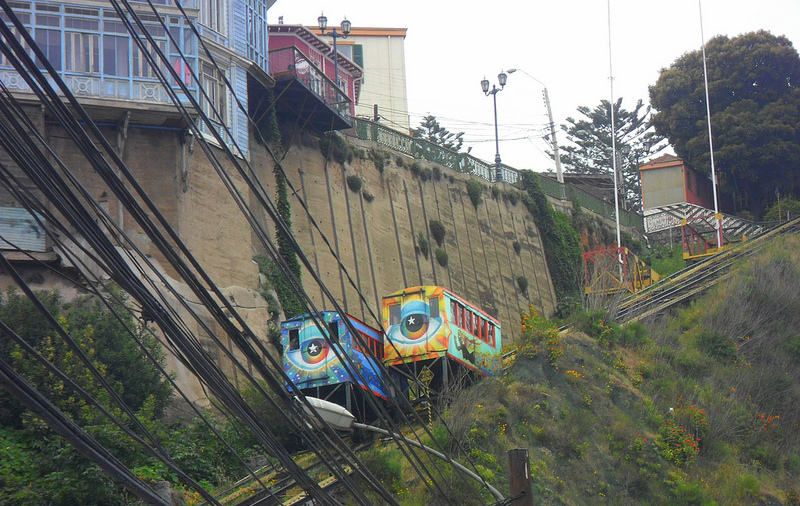
New York-based artist Nicolina painted the cars on Ascensor Artillería. Photo © Jonathan Hood, licensed Creative Commons Attribution No-Derivatives.
Nothing else distinguishes Valparaíso so much as its hillside ascensores, or elevators, once 33 in number but now down to 14 or so with only half a dozen functional. Still, they’re such a part of the city that the Fundación Valparaíso uses the slogan “Un ascensor es un barrio” (“An elevator is a neighborhood,” as their intimacy encourages interaction). English, German, French, Yugoslav, and other immigrants who had made their fortunes in business, finance, and mining built mansions and houses in the hills, but the precipitous topography and complicated street plan created access problems.Only Ascensor Polanco is an elevator in the strictest sense of the word — the rest are funiculars. They date from the late 19th century; as the port, commercial, and financial districts quickly occupied the city’s limited level terrain, residential neighborhoods climbed and spread up the canyons and over the nearby hillsides.English, German, French, Yugoslav, and other immigrants who had made their fortunes in business, finance, and mining built mansions and houses in the hills, but the precipitous topography and complicated street plan created access problems. The elegant solution was the ascensores, which carried residents quickly and directly to their neighborhoods.
At their peak, more than 13 million people used them every year; during the second half of the 20th century, though, roads and vehicles invaded the hills, so that only about 3 million per year use them now. Without operating subsidies, even more might close.
As Valparaíso achieved World Heritage Site status, the remaining ascensores were one of the attractions that made the city unique. Improving the surrounding areas with better sidewalks, ornamentation, lighting, and landscaping has encouraged a vigorous street life in areas that, until recently, were considered marginal neighborhoods.
All ascensores charge small fares, and there may soon be a differential rate for tourists; some are privately operated, while others are public. For more details, those who can read Spanish should see Juan Cameron’s Ascensores Porteños (Viña del Mar/Santiago: Ediciones Altazor, 1998).
Excerpted from the Fourth Edition of Moon Chile.